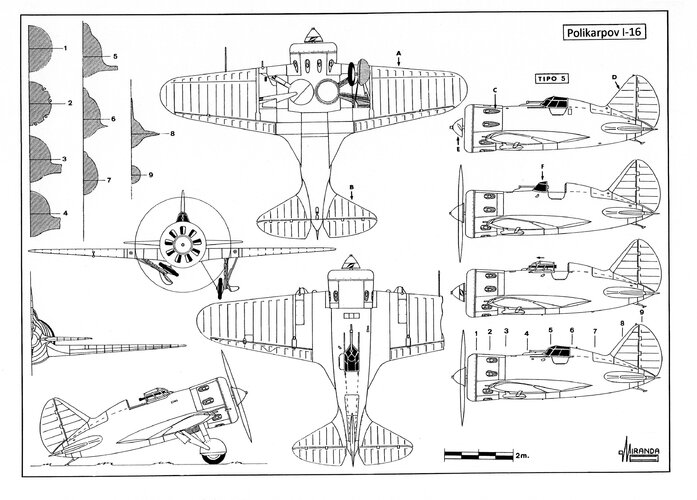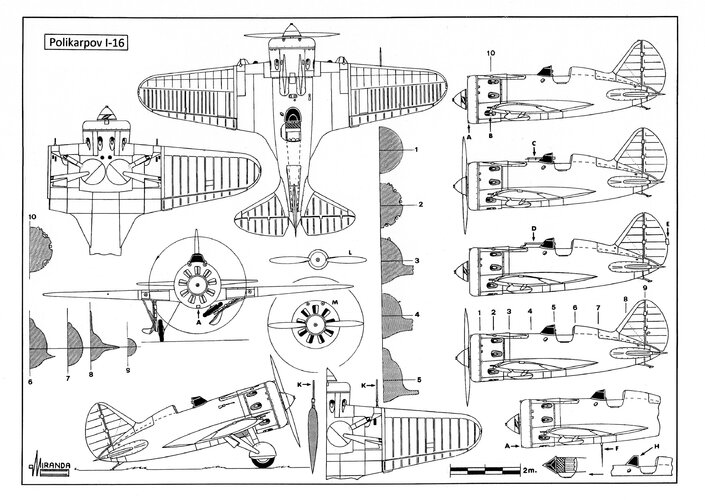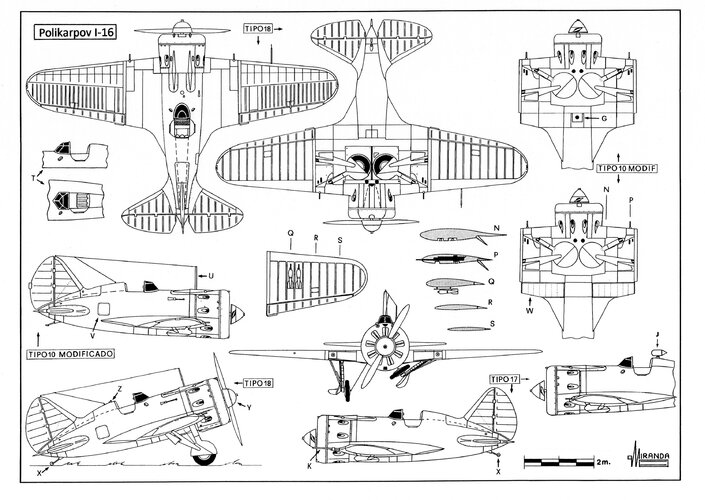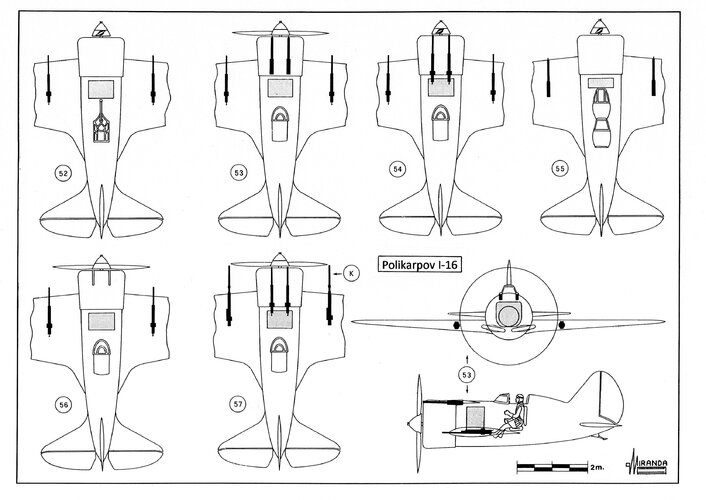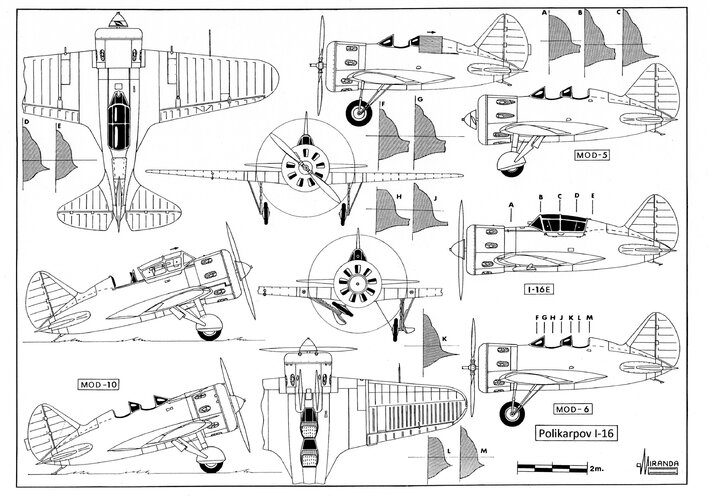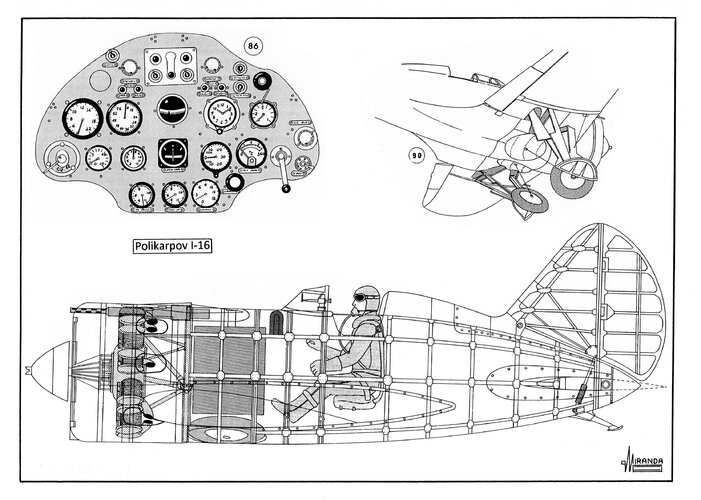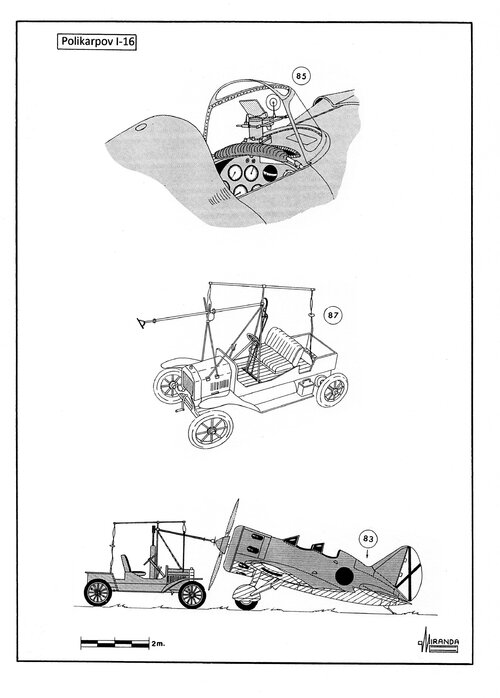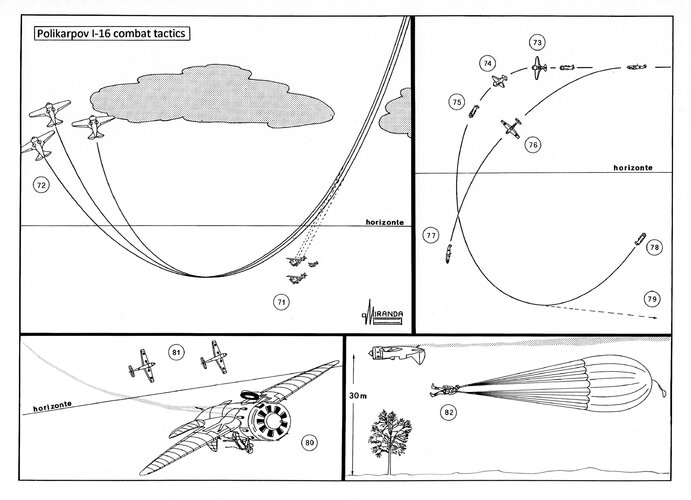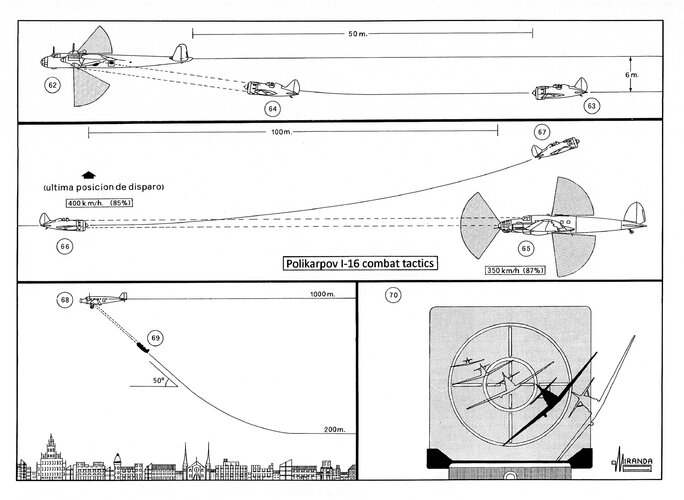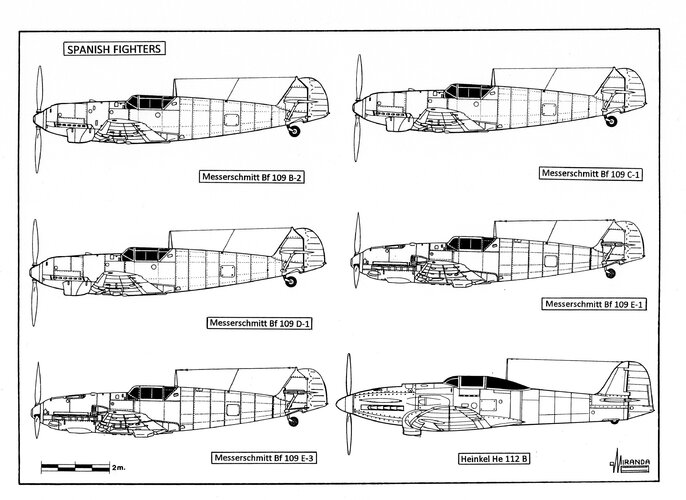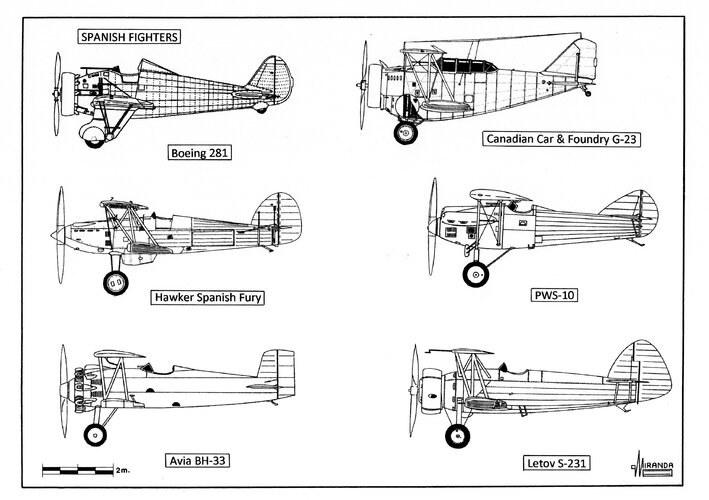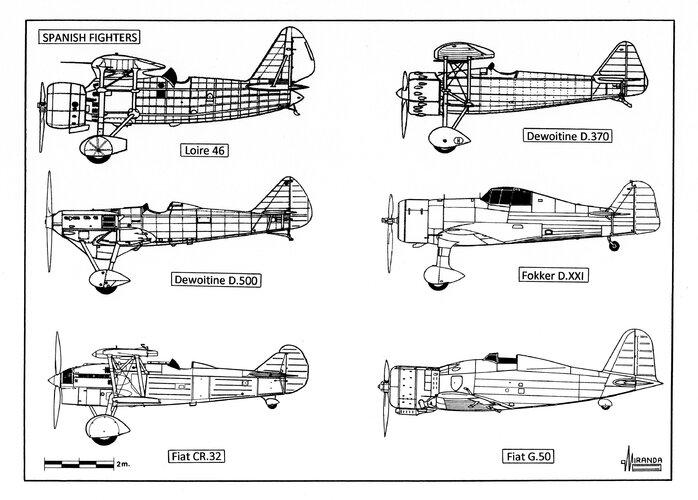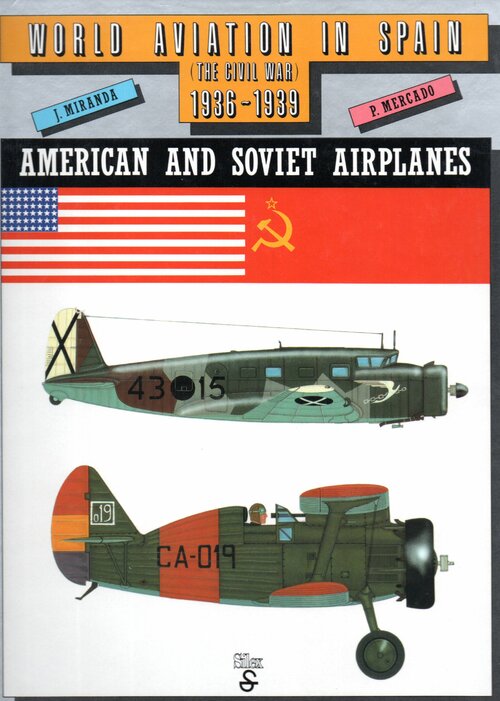The first batch of 31 Polikarpov I-16 Type 5 fighters (the strength of a Soviet Fighter Regiment) arrived in Spain at the end of October 1936.
The Republican ground crews in charge of assembling the aircraft called the new fighter Mosca (fly) because of the Russian word MOCKBA written on the delivery crates from GAZ-1 factory in Moscow.
The planes arrived painted overall with the factory primer Greenish Grey and lacquered anti-corrosion Black in both propeller spinner and engine cowling.
When the I-16 entered combat, on November 15, the Nationalist pilots dubbed it Rata (rat) because of its unusual paint scheme, and to the tactic used against the Ju 52/3m bombers attacking them from below, climbing at 50 degrees (drawings 68 and 69).
The Type 5 outperformed the Fiat C.R.32 in armament, speed and climb rate, but the Italian fighter surpassed it in maneuverability.
When soviet pilots performed 'hit and run' tactics, using cloud cover to advantage (drawings 71 and 72) the Type 5 quickly gained air superiority against the Nationalist biplanes Fiat C.R.32 and Heinkel He-51B.
But the I-16 was also a pilot killer with poor longitudinal stability, tailplane and undercarriage buffeting problems, marked tendency to stalling on landing approach and dangerous engine cuts due to the contamination of the fuel with rubber particles from the inner lining of the self-sealing fuel tank.
The narrow sliding canopy would restrict the pilot head movements to check the rear. All flights were performed with the canopy in open position due the high landing accident rate and also to the contamination of the cockpit with carbon monoxide from the poorly designed tear drop exhaust ports.
Most of the Spanish airfields were too short to accommodate the I-16 landing run in safety. The use of the brakes on landing frequently caused nose down accidents and pilots preferred to use the aerodynamic force of the tailplane elevator to press against the ground the tail skid.
The high number of accidents made it necessary to import four UTI-4 two-seat airplanes in May 1937 to retrain the pilots.
The Republican air raid warning system was not sufficiently effective organization and its alarm siren often sound only five to ten minutes before the German fast bombers flew over their airfields.
The use of the Hucks starter system (drawings 83 and 87) could also delay until ten minutes the take-off of a squadron of I-16 fighters.
The undercarriage retraction required 45 turns of the hand crank mounted in the cockpit starboard side and the control stick had a racquet-shaped grip so that the pilot could control the plane with his left hand.
The I-16 instability in a climb demanded the highest concentration on the part of the pilot who often preferred to hold the stick between the knees to control the throttle with the left hand.
As a result the Republican fighters were often surprised climbing at medium level and suffered heavy combat losses.
Sometimes the wheels did not completely retract, due to an abnormal extension of the cables, generating drag and turbulence.
When the unfolding mechanism failed (drawing 90) the landing gear could only be fully lowered after performing a high G maneuver, sometimes the pilot had to free it by cutting the cables with pliers.
In an attempt to solve the problem of excessive landing speed (118 mph) flaps powered by compressed air were experimentally installed under the wings of one Type 5, but its use required some practice and the Soviet pilot Romanov was killed during tests, in June 1937.
The Type 5 was armed with two wing mounted ShKAS “K” mod. 1935 machine guns of 7.62 mm, with 1,800 rpm.
It was very unsatisfactory as gun platform with the bad lateral stability usual on short-fuselage aircraft. The fighter also suffered directional snaking problems at high speeds, affecting weapon precision during combat maneuvers.
Their machine guns had harmonized the convergence at 400 m worsened the aiming with OP-1 gunsight, in 1938 the convergence was harmonized at 50 m only.
The Shvetsov M-25 engine was basically a Soviet copy of the American Wright Cyclone SGR-1820-F-3, with Stromberg NA-F-7C carburetor and Scintilla ignition system.
The instrument gauges were Pioneer-Bendix built under license (drawing 86).
Polikarpov I-16 Type 5 technical data
Power plant: one Shvetsov M-25 V radial engine rated at 750 hp. (Soviet version of Wright Cyclone SR-1820-F-3 built under license) driving one V-25 metal propeller built under license Hamilton-Standard, wingspan: 29.5 ft. (9 m), length: 19.4 ft. (5.9 m), height: 8.4 ft. (2.56 m), wing surface: 161.5 sq. ft. (14.54 sq. m), maximum weight: 3,220 lb. (1,460 kg), maximum speed: 282 mph (454 km/h), landing speed: 118 mph (190 km/h), service ceiling: 30,176 ft. (9,200 m), armament: two wing mounted ShKAS “K” mod.1935 machine guns of 7.62 mm with 1,800 rpm (drawing 52).
At the end of December 1936 a second batch of 31 Type 5 fighters arrived in Spain, all of these aircraft had been manufactured at the Gorky GAZ-21 factory and were delivered with the upper surfaces painted in Olive Green and the lower surfaces in Light Blue.
When the Heinkel He 51B combat inadequacies became apparent, the airplane was relegated to ground attack missions and the fighter role in the Nationalist air force was ably taken up by the Italian biplane Fiat C.R.32, only marginally superior to the German fighter.
After learning the results of the operational tests carried out by the Messerschmitt Bf 109 V3, V4 and V5 prototypes in January 1937, the Reichsluftahrtministerium (RLM) decided to reinforce the Legion Condor with 16 Bf 109 B-1 Luftwaffe service fighters together with the staff of II/JG 132 unit.
In March 1937 the new fighters arrived in Spain painted in overall RLM 63 Lichtgrau (Light grey) air superiority scheme, and they entered combat on April 16, 1937 surprising the Soviet pilots with their superior speed and ceiling.
The Spanish Bf 109 B-1s were only armed with two MG 17 machine guns of 7.92 mm with 1,200 rpm and their Jumo 210 D engine, driving an old wooden, two-bladed, fixed-pitch Schwarz propeller, it was 80 hp. less powerful than the I-16, but the use of the new Auer Werke high-altitude oxygen mask allowed German pilots to ascend up to 8,200 m, a height unattainable for the Type 5 interceptors.
The Messerschmitts operated in Rotte formations of only two aircraft and their paint scheme made them virtually invisible from the 3,500 m altitude at which the Soviets used to fly.
The Germans began to use 'hit and run' tactics that the Type 5 pilots could only counter, when not surprised, using the defensive tactics of the I-15, but the Type 5 took eight seconds to perform the maniobra Pedivalov and at 4,000 m the Messerschmitt could exceed 435 mph (700 km/h) in dive.
Knowing that the structural limit of the B-1 was 790 km/h, many Soviet pilots dived to their deaths because of compressibility. Flying at 497 mph (800 km/h) the Type 5 could become a death trap when the transonic shockwave generated by the poorly designed cowling engine blocked the tailplane elevator. Some pilots managed to survive the experience by tilting the plane 90 degrees to use the rudder in elevator operation.
In order to obtain numerical superiority over the Messerschmitts the Soviets sent to Spain 31 Polikarpov Type 6 in May 1937, 12 Type 5 in June and 15 Type 5 and 37 Type 6 in July.
The Type 6 fighters of the first batch, from the production line at GAZ-21 factory, differed from the Type 5 in its M-25A engine of only 730 hp. In this model the exhaust ports on the engine cowling had a more rounded rear section to avoid contamination of the cockpit with carbon monoxide.
The second batch of Type 6 aircraft were manufactured on the GAZ-153 and differed by their fixed single piece windscreen which provided the pilot with a better overall view, although they retained the OP-1 gunsight.
The Type 6 was heavier and slower than the Type 5 due to its strengthened airframe.
Polikarpov I-16 Type 6 technical data
Power plant: one Shvetsov M-25 A radial engine rated at 730 hp. (Soviet version of Wright Cyclone SR-1820-F-3 built under license) driving one V-25 metal propeller built under license Hamilton-Standard, wingspan: 29.5 ft. (9 m), length: 19.4 ft. (5.9 m), height: 8.3 ft. (2.52 m), wing surface: 161.5 sq. ft. (14.54 sq. m), maximum weight: 3,664 lb. (1,660 kg), maximum speed: 273 mph (440 km/h), landing speed: 118 mph (190 km/h), service ceiling: 29,848 ft. (9,100 m), armament: two wing mounted ShKAS “K” mod.1935 machine guns of 7.62 mm with 1,800 rpm (drawing 56).
In June 1937 the Germans sent to Spain 22 Messerschmitt Bf 109 B-2 fighters powered by a Jumo 210 Da engine rated at 680 hp. driving a VDM C-4 two-bladed, variable pitch metal propeller. Its maximum speed was 292 mph (470 km/h) and its combat ceiling was 29,520 ft. (9,000 m).
The new German fighter was an extremely stable gun platform and easy to handle at low speed thanks to the use of effective flaps and wing slats. It turned out even more deadly than the B-1 achieving ultimate air superiority in September 1937.
The B-2 suffered serious structural problems, at least one plane lost its starboard wing during high G maneuvers and ten units had to be sent to Germany for structural review.
In August 1937 four Bf 109 prototypes (V7, V9, V13 and V14) powered by Jumo 210 Ga and DB 600 engines were winners of the Fourth International Air Meeting at Zurich-Dübendorf and the V13 set a World Record of Speed, on November 1937, flying at 610.95 km/h.
In March 1938 the Soviets sent to Spain 31 Polikarpov I-16 Type 10. In an attempt to overtake the Messerschmitt in firepower the Type 10 was designed with four ShKAS, but the synchronized "S" version was not yet available and the aircraft arrived armed with two engine mounted PV-1 machine guns with 680 rpm (drawing 53).
The Type 10 had the same engine and similar performances as the Type 6 but its greater firepower was not an advantage in the fight against the German bombers. Even the British Hawker Hurricane Mk.I armed with eight machine guns had difficulty shooting down a Heinkel He 111 with 270 kg armor.
The last generation of German bombers acquired in Spain a reputation of invulnerability, helped by the Nazi propaganda and the hysterics of the French press.
Polikarpov I-16 Type 10 (1st and 2nd batches) technical data
Power plant: one Shvetsov M-25 A radial engine rated at 730 hp. (Soviet version of Wright Cyclone SR-1820-F-3 built under license) driving one V-25 metal propeller built under license Hamilton-Standard, wingspan: 29.5 ft. (9 m), length: 19.4 ft. (5.9 m), height: 8.3 ft. (2.52 m), wing surface: 161.5 sq. ft. (14.54 sq. m), maximum weight: 3,753 lb. (1,700 kg), maximum speed: 273 mph (440 km/h), landing speed: 124 mph (200 km/h), service ceiling: 29,848 ft. (9,100 m), armament: two wing mounted ShKAS “K” mod.1935 machine guns of 7.62 mm with 1,800 rpm and two engine mounted PV-1 machine guns of 7.62 mm with 680 rpm (drawing 53).
In April 1938, five Messerschmitt Bf 109 C-1 fighters arrived in Spain to test new combat tactics using the new R/T FuG 7 devices.
The C-1 was powered by one Jumo 210 Ga rated at 700 hp. and armed with four MG 17 machine guns. The weight gain reduced the top speed to 290 mph (467 km/h) and the ceiling to 27,552 ft. (8,400 m).
In July 1938 the Messerschmitts achieved the highest number of Republican aircraft shoot-downs achieved in the entire war.
In August, five Bf 109 D-1s arrived to practice combat tactics using Vierfingerscharm (finger four) formations composed of two Rotte.
That same month the Soviets sent a second batch of 31 Type 10s armed with PV-1 and ShKAS but their arrival hardly served to compensate for the casualties suffered at July.
In September came another 29 Type 10s fitted with flaps, M-25V engines rated at 750 hp, four ShKAS (drawing 54) and PAK-1 reflex gunsights (drawings 70 and 85) a copy of the French Clair gunsight.
The M-25V with single-speed supercharger and K-25-4D carburetor gave the Type 10 the ability to fly at 27,126 ft. (8,270 m) but the absence of oxygen equipment limited its combat ceiling to 11,480 ft. (3,500 m).
Polikarpov I-16 Type 10 (3rd and 4th batches) technical data
Power plant: one Shvetsov M-25 V radial engine rated at 750 hp. (Soviet version of Wright Cyclone SR-1820-F-3 built under license) driving one V-25 metal propeller built under license Hamilton-Standard, wingspan: 29.5 ft. (9 m), length: 19.8 ft. (6.03 m), height: 8.4 ft. (2.56 m), wing surface: 161.5 sq. ft. (14.54 sq. m), maximum weight: 3,775 lb. (1,710 kg), maximum speed: 286 mph (460 km/h), service ceiling: 27,126 ft. (8,270 m), armament: two wing mounted ShKAS “K” mod.1935 machine guns of 7.62 mm with 1,800 rpm and two engine mounted ShKAS “S” mod.1937 synchronized machine guns of 7.62 mm with 1,625 rpm, equipment: PAK-1 reflex gunsight.
In October 1938 the Soviet Union sending a final batch of 31 Type 10 fighters before abandoning the Spanish war as a lost cause and the supply of aircraft ceased.
In November the Spanish Republicans decided to modify the last Type 10s received by installing new Wright Cyclone R-1820-F-54 engines purchased through Estonia. The modification included the installation of an armor plate and homemade oxygen equipment.
For the first time in the entire War, Republican fighters were able to take on the German fighters and bombers with dignity, flying at 32,800 ft. (10,000 m).
The tactic used against the Dornier Do 17 required a long chase, due to the small difference in speeds, and a rat-type ventral attack (drawings 62, 63 and 64).
The Heinkel He 111 had a very thick wing that protected the engines and fuel tanks against attacks from behind, only a frontal attack was possible hoping that the combined speed of both aircraft would increase the destructive power of the 7.62 mm bullets (drawings 65, 66 and 67).
During the last months of the War the Soviets of the Quinta Escuadrilla Mosca conducted operational tests with the Type17 prototype armed with two ShVAK 20 mm cannons (drawing 57).
Polikarpov I-16 Type 10 (4th batch modified) technical data
Power plant: one Wright Cyclone SR-1820-F-54 radial engine rated at 775 hp. driving one V-25 metal propeller built under license Hamilton-Standard, wingspan: 29.5 ft. (9 m), length: 19.8 ft. (6.03 m), height: 8.4 ft. (2.56 m), wing surface: 161.5 sq. ft. (14.54 sq. m), maximum weight: 4,084 lb. (1,850 kg), maximum speed: 286 mph (460 km/h), service ceiling: 32,800 ft. (10,000 m), armament: two wing mounted ShKAS “K” mod.1935 of 7.62 mm machine guns with 1,800 rpm and two engine mounted ShKAS “S” mod.1937 synchronized of 7.62 mm machine guns with 1,625 rpm (drawing 54), equipment: PAK-1 reflex gunsight (drawings 70 and 85), oxygen and armor plates.
When the Bf 109 E-1 powered by 1,000 hp. engines arrived, the technological difference with the I-16 was already so great that the Soviet fighter could only resort to evasive maneuvers to survive (drawings 73 to 79). Soviet propaganda accused the Germans of shooting on defenseless pilots while parachuting down, to avoid this some Soviet pilots survived after jumping at high speed in ballistic trajectory from their plane in an inverted position, flying at only 30 m altitude! (drawings 80, 81 and 82).
The Republican ground crews in charge of assembling the aircraft called the new fighter Mosca (fly) because of the Russian word MOCKBA written on the delivery crates from GAZ-1 factory in Moscow.
The planes arrived painted overall with the factory primer Greenish Grey and lacquered anti-corrosion Black in both propeller spinner and engine cowling.
When the I-16 entered combat, on November 15, the Nationalist pilots dubbed it Rata (rat) because of its unusual paint scheme, and to the tactic used against the Ju 52/3m bombers attacking them from below, climbing at 50 degrees (drawings 68 and 69).
The Type 5 outperformed the Fiat C.R.32 in armament, speed and climb rate, but the Italian fighter surpassed it in maneuverability.
When soviet pilots performed 'hit and run' tactics, using cloud cover to advantage (drawings 71 and 72) the Type 5 quickly gained air superiority against the Nationalist biplanes Fiat C.R.32 and Heinkel He-51B.
But the I-16 was also a pilot killer with poor longitudinal stability, tailplane and undercarriage buffeting problems, marked tendency to stalling on landing approach and dangerous engine cuts due to the contamination of the fuel with rubber particles from the inner lining of the self-sealing fuel tank.
The narrow sliding canopy would restrict the pilot head movements to check the rear. All flights were performed with the canopy in open position due the high landing accident rate and also to the contamination of the cockpit with carbon monoxide from the poorly designed tear drop exhaust ports.
Most of the Spanish airfields were too short to accommodate the I-16 landing run in safety. The use of the brakes on landing frequently caused nose down accidents and pilots preferred to use the aerodynamic force of the tailplane elevator to press against the ground the tail skid.
The high number of accidents made it necessary to import four UTI-4 two-seat airplanes in May 1937 to retrain the pilots.
The Republican air raid warning system was not sufficiently effective organization and its alarm siren often sound only five to ten minutes before the German fast bombers flew over their airfields.
The use of the Hucks starter system (drawings 83 and 87) could also delay until ten minutes the take-off of a squadron of I-16 fighters.
The undercarriage retraction required 45 turns of the hand crank mounted in the cockpit starboard side and the control stick had a racquet-shaped grip so that the pilot could control the plane with his left hand.
The I-16 instability in a climb demanded the highest concentration on the part of the pilot who often preferred to hold the stick between the knees to control the throttle with the left hand.
As a result the Republican fighters were often surprised climbing at medium level and suffered heavy combat losses.
Sometimes the wheels did not completely retract, due to an abnormal extension of the cables, generating drag and turbulence.
When the unfolding mechanism failed (drawing 90) the landing gear could only be fully lowered after performing a high G maneuver, sometimes the pilot had to free it by cutting the cables with pliers.
In an attempt to solve the problem of excessive landing speed (118 mph) flaps powered by compressed air were experimentally installed under the wings of one Type 5, but its use required some practice and the Soviet pilot Romanov was killed during tests, in June 1937.
The Type 5 was armed with two wing mounted ShKAS “K” mod. 1935 machine guns of 7.62 mm, with 1,800 rpm.
It was very unsatisfactory as gun platform with the bad lateral stability usual on short-fuselage aircraft. The fighter also suffered directional snaking problems at high speeds, affecting weapon precision during combat maneuvers.
Their machine guns had harmonized the convergence at 400 m worsened the aiming with OP-1 gunsight, in 1938 the convergence was harmonized at 50 m only.
The Shvetsov M-25 engine was basically a Soviet copy of the American Wright Cyclone SGR-1820-F-3, with Stromberg NA-F-7C carburetor and Scintilla ignition system.
The instrument gauges were Pioneer-Bendix built under license (drawing 86).
Polikarpov I-16 Type 5 technical data
Power plant: one Shvetsov M-25 V radial engine rated at 750 hp. (Soviet version of Wright Cyclone SR-1820-F-3 built under license) driving one V-25 metal propeller built under license Hamilton-Standard, wingspan: 29.5 ft. (9 m), length: 19.4 ft. (5.9 m), height: 8.4 ft. (2.56 m), wing surface: 161.5 sq. ft. (14.54 sq. m), maximum weight: 3,220 lb. (1,460 kg), maximum speed: 282 mph (454 km/h), landing speed: 118 mph (190 km/h), service ceiling: 30,176 ft. (9,200 m), armament: two wing mounted ShKAS “K” mod.1935 machine guns of 7.62 mm with 1,800 rpm (drawing 52).
At the end of December 1936 a second batch of 31 Type 5 fighters arrived in Spain, all of these aircraft had been manufactured at the Gorky GAZ-21 factory and were delivered with the upper surfaces painted in Olive Green and the lower surfaces in Light Blue.
When the Heinkel He 51B combat inadequacies became apparent, the airplane was relegated to ground attack missions and the fighter role in the Nationalist air force was ably taken up by the Italian biplane Fiat C.R.32, only marginally superior to the German fighter.
After learning the results of the operational tests carried out by the Messerschmitt Bf 109 V3, V4 and V5 prototypes in January 1937, the Reichsluftahrtministerium (RLM) decided to reinforce the Legion Condor with 16 Bf 109 B-1 Luftwaffe service fighters together with the staff of II/JG 132 unit.
In March 1937 the new fighters arrived in Spain painted in overall RLM 63 Lichtgrau (Light grey) air superiority scheme, and they entered combat on April 16, 1937 surprising the Soviet pilots with their superior speed and ceiling.
The Spanish Bf 109 B-1s were only armed with two MG 17 machine guns of 7.92 mm with 1,200 rpm and their Jumo 210 D engine, driving an old wooden, two-bladed, fixed-pitch Schwarz propeller, it was 80 hp. less powerful than the I-16, but the use of the new Auer Werke high-altitude oxygen mask allowed German pilots to ascend up to 8,200 m, a height unattainable for the Type 5 interceptors.
The Messerschmitts operated in Rotte formations of only two aircraft and their paint scheme made them virtually invisible from the 3,500 m altitude at which the Soviets used to fly.
The Germans began to use 'hit and run' tactics that the Type 5 pilots could only counter, when not surprised, using the defensive tactics of the I-15, but the Type 5 took eight seconds to perform the maniobra Pedivalov and at 4,000 m the Messerschmitt could exceed 435 mph (700 km/h) in dive.
Knowing that the structural limit of the B-1 was 790 km/h, many Soviet pilots dived to their deaths because of compressibility. Flying at 497 mph (800 km/h) the Type 5 could become a death trap when the transonic shockwave generated by the poorly designed cowling engine blocked the tailplane elevator. Some pilots managed to survive the experience by tilting the plane 90 degrees to use the rudder in elevator operation.
In order to obtain numerical superiority over the Messerschmitts the Soviets sent to Spain 31 Polikarpov Type 6 in May 1937, 12 Type 5 in June and 15 Type 5 and 37 Type 6 in July.
The Type 6 fighters of the first batch, from the production line at GAZ-21 factory, differed from the Type 5 in its M-25A engine of only 730 hp. In this model the exhaust ports on the engine cowling had a more rounded rear section to avoid contamination of the cockpit with carbon monoxide.
The second batch of Type 6 aircraft were manufactured on the GAZ-153 and differed by their fixed single piece windscreen which provided the pilot with a better overall view, although they retained the OP-1 gunsight.
The Type 6 was heavier and slower than the Type 5 due to its strengthened airframe.
Polikarpov I-16 Type 6 technical data
Power plant: one Shvetsov M-25 A radial engine rated at 730 hp. (Soviet version of Wright Cyclone SR-1820-F-3 built under license) driving one V-25 metal propeller built under license Hamilton-Standard, wingspan: 29.5 ft. (9 m), length: 19.4 ft. (5.9 m), height: 8.3 ft. (2.52 m), wing surface: 161.5 sq. ft. (14.54 sq. m), maximum weight: 3,664 lb. (1,660 kg), maximum speed: 273 mph (440 km/h), landing speed: 118 mph (190 km/h), service ceiling: 29,848 ft. (9,100 m), armament: two wing mounted ShKAS “K” mod.1935 machine guns of 7.62 mm with 1,800 rpm (drawing 56).
In June 1937 the Germans sent to Spain 22 Messerschmitt Bf 109 B-2 fighters powered by a Jumo 210 Da engine rated at 680 hp. driving a VDM C-4 two-bladed, variable pitch metal propeller. Its maximum speed was 292 mph (470 km/h) and its combat ceiling was 29,520 ft. (9,000 m).
The new German fighter was an extremely stable gun platform and easy to handle at low speed thanks to the use of effective flaps and wing slats. It turned out even more deadly than the B-1 achieving ultimate air superiority in September 1937.
The B-2 suffered serious structural problems, at least one plane lost its starboard wing during high G maneuvers and ten units had to be sent to Germany for structural review.
In August 1937 four Bf 109 prototypes (V7, V9, V13 and V14) powered by Jumo 210 Ga and DB 600 engines were winners of the Fourth International Air Meeting at Zurich-Dübendorf and the V13 set a World Record of Speed, on November 1937, flying at 610.95 km/h.
In March 1938 the Soviets sent to Spain 31 Polikarpov I-16 Type 10. In an attempt to overtake the Messerschmitt in firepower the Type 10 was designed with four ShKAS, but the synchronized "S" version was not yet available and the aircraft arrived armed with two engine mounted PV-1 machine guns with 680 rpm (drawing 53).
The Type 10 had the same engine and similar performances as the Type 6 but its greater firepower was not an advantage in the fight against the German bombers. Even the British Hawker Hurricane Mk.I armed with eight machine guns had difficulty shooting down a Heinkel He 111 with 270 kg armor.
The last generation of German bombers acquired in Spain a reputation of invulnerability, helped by the Nazi propaganda and the hysterics of the French press.
Polikarpov I-16 Type 10 (1st and 2nd batches) technical data
Power plant: one Shvetsov M-25 A radial engine rated at 730 hp. (Soviet version of Wright Cyclone SR-1820-F-3 built under license) driving one V-25 metal propeller built under license Hamilton-Standard, wingspan: 29.5 ft. (9 m), length: 19.4 ft. (5.9 m), height: 8.3 ft. (2.52 m), wing surface: 161.5 sq. ft. (14.54 sq. m), maximum weight: 3,753 lb. (1,700 kg), maximum speed: 273 mph (440 km/h), landing speed: 124 mph (200 km/h), service ceiling: 29,848 ft. (9,100 m), armament: two wing mounted ShKAS “K” mod.1935 machine guns of 7.62 mm with 1,800 rpm and two engine mounted PV-1 machine guns of 7.62 mm with 680 rpm (drawing 53).
In April 1938, five Messerschmitt Bf 109 C-1 fighters arrived in Spain to test new combat tactics using the new R/T FuG 7 devices.
The C-1 was powered by one Jumo 210 Ga rated at 700 hp. and armed with four MG 17 machine guns. The weight gain reduced the top speed to 290 mph (467 km/h) and the ceiling to 27,552 ft. (8,400 m).
In July 1938 the Messerschmitts achieved the highest number of Republican aircraft shoot-downs achieved in the entire war.
In August, five Bf 109 D-1s arrived to practice combat tactics using Vierfingerscharm (finger four) formations composed of two Rotte.
That same month the Soviets sent a second batch of 31 Type 10s armed with PV-1 and ShKAS but their arrival hardly served to compensate for the casualties suffered at July.
In September came another 29 Type 10s fitted with flaps, M-25V engines rated at 750 hp, four ShKAS (drawing 54) and PAK-1 reflex gunsights (drawings 70 and 85) a copy of the French Clair gunsight.
The M-25V with single-speed supercharger and K-25-4D carburetor gave the Type 10 the ability to fly at 27,126 ft. (8,270 m) but the absence of oxygen equipment limited its combat ceiling to 11,480 ft. (3,500 m).
Polikarpov I-16 Type 10 (3rd and 4th batches) technical data
Power plant: one Shvetsov M-25 V radial engine rated at 750 hp. (Soviet version of Wright Cyclone SR-1820-F-3 built under license) driving one V-25 metal propeller built under license Hamilton-Standard, wingspan: 29.5 ft. (9 m), length: 19.8 ft. (6.03 m), height: 8.4 ft. (2.56 m), wing surface: 161.5 sq. ft. (14.54 sq. m), maximum weight: 3,775 lb. (1,710 kg), maximum speed: 286 mph (460 km/h), service ceiling: 27,126 ft. (8,270 m), armament: two wing mounted ShKAS “K” mod.1935 machine guns of 7.62 mm with 1,800 rpm and two engine mounted ShKAS “S” mod.1937 synchronized machine guns of 7.62 mm with 1,625 rpm, equipment: PAK-1 reflex gunsight.
In October 1938 the Soviet Union sending a final batch of 31 Type 10 fighters before abandoning the Spanish war as a lost cause and the supply of aircraft ceased.
In November the Spanish Republicans decided to modify the last Type 10s received by installing new Wright Cyclone R-1820-F-54 engines purchased through Estonia. The modification included the installation of an armor plate and homemade oxygen equipment.
For the first time in the entire War, Republican fighters were able to take on the German fighters and bombers with dignity, flying at 32,800 ft. (10,000 m).
The tactic used against the Dornier Do 17 required a long chase, due to the small difference in speeds, and a rat-type ventral attack (drawings 62, 63 and 64).
The Heinkel He 111 had a very thick wing that protected the engines and fuel tanks against attacks from behind, only a frontal attack was possible hoping that the combined speed of both aircraft would increase the destructive power of the 7.62 mm bullets (drawings 65, 66 and 67).
During the last months of the War the Soviets of the Quinta Escuadrilla Mosca conducted operational tests with the Type17 prototype armed with two ShVAK 20 mm cannons (drawing 57).
Polikarpov I-16 Type 10 (4th batch modified) technical data
Power plant: one Wright Cyclone SR-1820-F-54 radial engine rated at 775 hp. driving one V-25 metal propeller built under license Hamilton-Standard, wingspan: 29.5 ft. (9 m), length: 19.8 ft. (6.03 m), height: 8.4 ft. (2.56 m), wing surface: 161.5 sq. ft. (14.54 sq. m), maximum weight: 4,084 lb. (1,850 kg), maximum speed: 286 mph (460 km/h), service ceiling: 32,800 ft. (10,000 m), armament: two wing mounted ShKAS “K” mod.1935 of 7.62 mm machine guns with 1,800 rpm and two engine mounted ShKAS “S” mod.1937 synchronized of 7.62 mm machine guns with 1,625 rpm (drawing 54), equipment: PAK-1 reflex gunsight (drawings 70 and 85), oxygen and armor plates.
When the Bf 109 E-1 powered by 1,000 hp. engines arrived, the technological difference with the I-16 was already so great that the Soviet fighter could only resort to evasive maneuvers to survive (drawings 73 to 79). Soviet propaganda accused the Germans of shooting on defenseless pilots while parachuting down, to avoid this some Soviet pilots survived after jumping at high speed in ballistic trajectory from their plane in an inverted position, flying at only 30 m altitude! (drawings 80, 81 and 82).

